Physical Address
304 North Cardinal St.
Dorchester Center, MA 02124
Physical Address
304 North Cardinal St.
Dorchester Center, MA 02124

A rental RV can tow your car, but hidden fees and restrictions await—discover the smarter alternatives that could save you thousands.
Most rental RV companies don’t advertise it, but you can actually tow a car behind their vehicles – though it’ll likely cost you extra and come with strict conditions. You’re looking at additional daily fees, mileage restrictions, and specific insurance requirements that many renters overlook until they’re already committed to their trip. Before you commit to hauling your vehicle cross-country, there are several vital factors you’ll need to take into account, plus some clever alternatives that might save you both money and hassle.
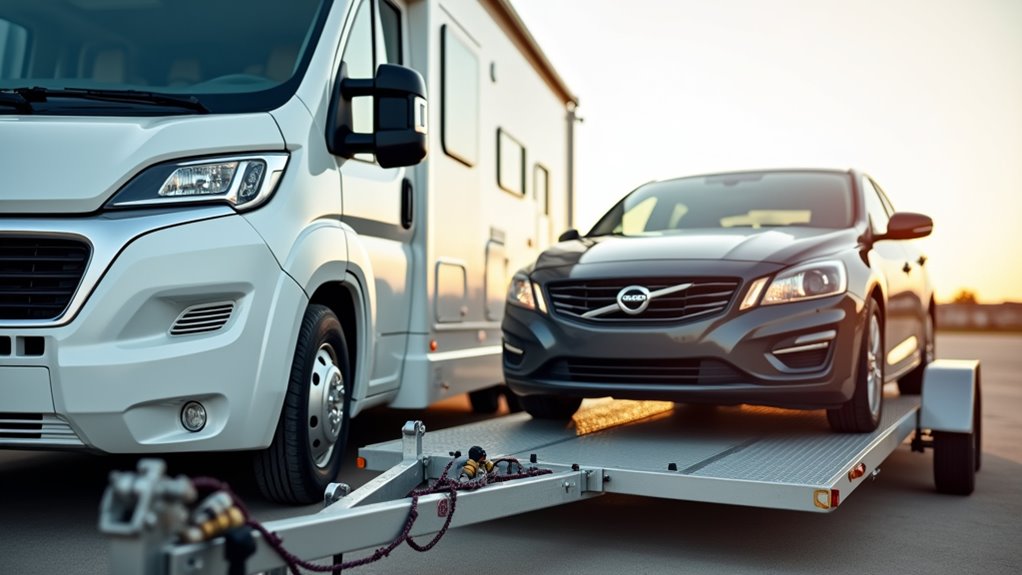
Before you hook up your car to that rental RV, you’ll need to navigate a maze of rental company policies that can make or break your trip.
Most rental companies require ownership approval before you can tow anything behind their RVs. You’ll likely need to give advance notice and declare your towing intentions upfront.
Check your rental agreement carefully—unauthorized towing can void your insurance coverage entirely, leaving you financially exposed.
Some companies restrict towing for one-way rentals or specific RV models, while others charge additional fees ranging from $20-$25 per night.
Don’t forget state regulations either. While most states accept standard driver’s licenses, larger trailers might require special permits.
Combined Gross Vehicle Weight laws vary by state, so research local towing regulations before hitting the road. Plus, you’ll need to ensure your towed vehicle has auxiliary brake systems installed, as these safety devices are legally required in most states for vehicles being pulled behind RVs.
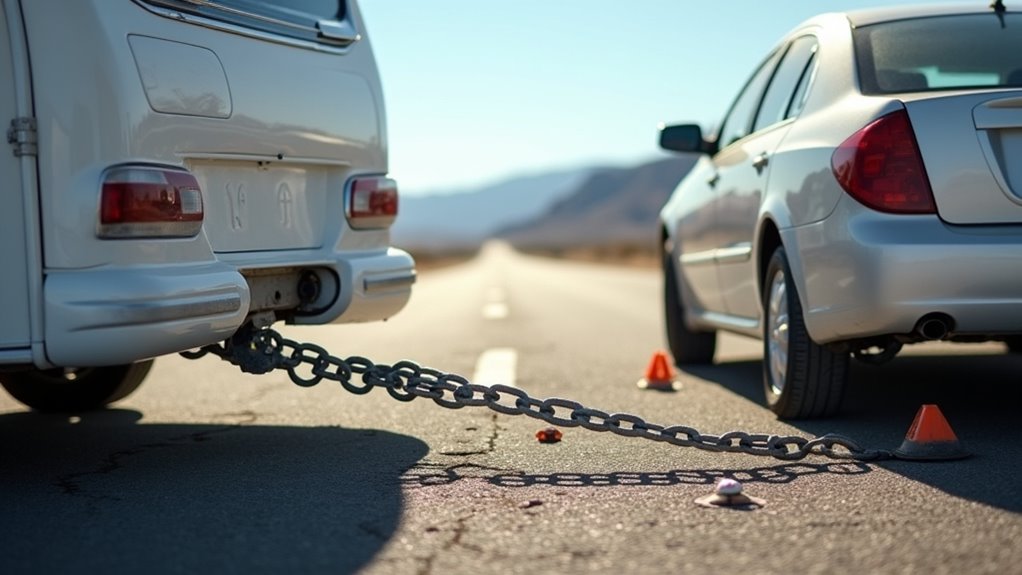
Once you’ve cleared the legal hurdles, you’ll face the hard mathematics of weight and size limits that can quickly turn your road trip dreams into expensive mistakes.
Your rental RV’s towing capacity isn’t negotiable – exceed it, and you’re risking catastrophic breakdowns and voided insurance coverage. Most states enforce a 65-foot combined length limit, meaning your RV plus car can’t stretch beyond that mark.
Exceed your RV’s towing limits and face catastrophic breakdowns, voided insurance, and expensive citations that destroy vacation budgets.
Here’s what you must verify before hitching up:
Exceeding these weight limits can significantly affect your vehicle’s handling and braking performance, creating dangerous driving conditions. Plus, safety chains are legally required for all trailers as a mandatory backup connection system. Knowing your vehicle’s towing capacity is essential to stay within legal and safe limits.
Miscalculate these numbers, and you’ll face expensive repairs, citations, or worse – accidents that could bankrupt your vacation budget.
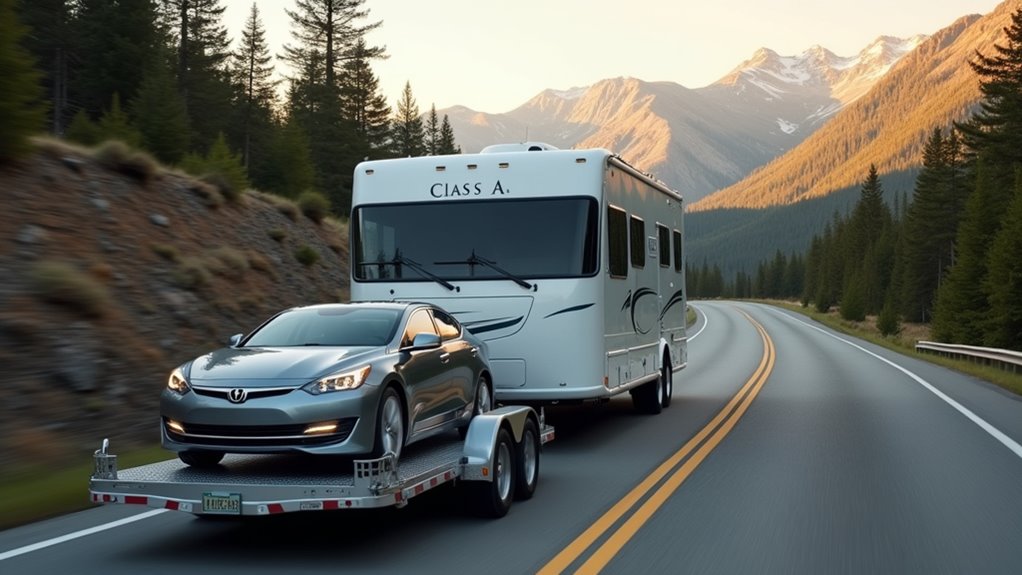
While your RV’s specs determine what you can tow, your car’s design dictates how you’ll tow it.
You’ve got three main options: flat towing, dollies, and trailers.
Flat towing connects your car directly behind the RV with all four wheels on the ground. It’s quick to set up and offers unlimited speed, but requires specific vehicle compatibility and sometimes costly modifications like auxiliary braking systems.
Dolly towing lifts your car’s front wheels off the ground. It’s cheaper upfront and works with more vehicles, reducing tire wear. However, setup takes longer and you’ll need storage space. Front-wheel drive cars work particularly well with dollies since they can be towed without incurring mileage or wear.
Trailer towing loads your entire car onto a platform. While it works with any vehicle, it’s expensive and complex to use, making it less popular for RV adventures.
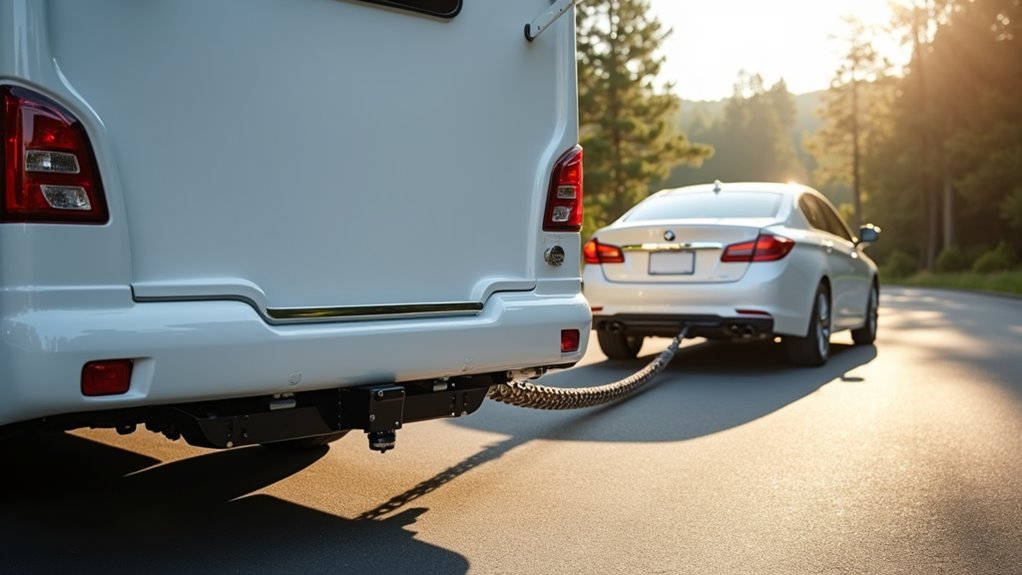
Since your rental RV can only handle so much weight, you’ll need to choose your towed vehicle carefully to stay within safe limits. Start by checking your RV’s towing capacity and GCWR in the owner’s manual. Remember, you shouldn’t exceed 90% of the maximum rating for safety. Consider these key factors when selecting your towed vehicle:
Always maintain that 20% safety buffer to account for unexpected weight additions. Don’t forget to factor in the weight of passengers and gear in your RV, as published towing specifications typically assume only the driver is present in the vehicle.

Three critical pieces of safety equipment form the backbone of any secure towing setup: tow bars with baseplates, safety cables or chains, and auxiliary braking systems.
Your tow bar creates the primary connection, while safety cables prevent dangerous separation if it fails—and they’re legally required in most states. Cross your chains and verify they’re strong enough for your vehicle’s weight.
Don’t skimp on auxiliary brakes. Without them, you’ll overload your RV’s braking system and create serious risks. Most states mandate auxiliary braking systems for towed vehicles to ensure safe stopping for both RV and towed vehicle.
Professional installation pays off here since improper setup can be dangerous.
You’ll also need a dinghy towing harness for synchronized lighting and consider tow bar locks for security.
Always inspect connections before departure and test your brake system’s activation. Properly maintaining towing safety equipment is essential for peace of mind on the road.
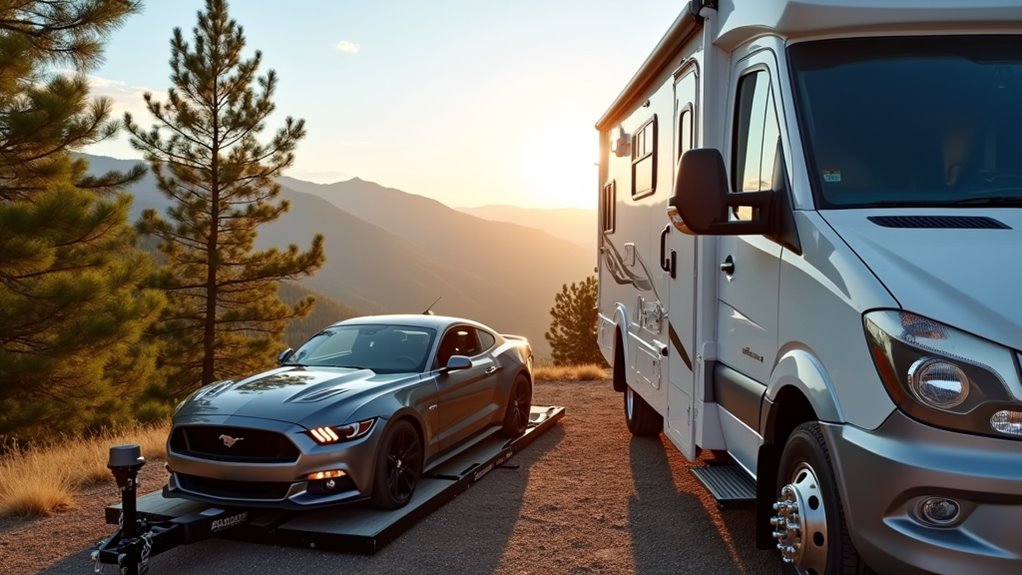
Before committing to the complexity and expense of towing a car behind your rental RV, you’ll want to explore simpler alternatives that might meet your transportation needs just as well.
These budget-friendly options often prove more practical than dealing with towing restrictions and additional rental fees:
Plus, understanding towing restrictions and rental policies can help you avoid unexpected costs or violations. You’ll save money, reduce stress, and avoid potential rental agreement violations while still maintaining mobility. Plus, consider that proper insurance coverage is essential if you do decide to tow, as rental companies typically aren’t responsible for damage to your towed vehicle.
You’ve researched towing capacities, studied rental agreements, and calculated weight limits—yet the simplest solution might be leaving your car behind entirely. That electric scooter you dismissed could zip you around town faster than unhitching a towed vehicle at every campground. Sometimes the most complex preparation leads you back to the most obvious answer: pack light, rent local, and let someone else worry about the towing headaches you’re trying to avoid.